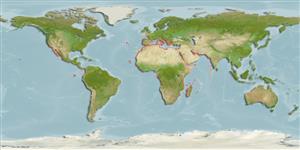Artemia salina (Linnaeus, 1758)
Brine shrimp| Native range | All suitable habitat | Point map | Year 2050 |

|
| This map was computer-generated and has not yet been reviewed. |
| Artemia salina AquaMaps Data sources: GBIF OBIS |
تصوير گوگل |
No photo available for this species.
رده بندی / Names اسامي عام | مترادف | CoL | ITIS | WoRMS
Branchiopoda | Anostraca | Artemiidae
Environment: milieu / climate zone / تغييرات عمق / distribution range بوم شناسي
; لب شور; تغييرات عمق 0 - 2 m (مرجع 80843). Tropical, preferred 23°C (مرجع 107945); 52°N - 35°S, 123°W - 75°E
Distribution كشورها | مناطق سازمان خوار و بار جهاني (FAO) | Ecosystems | ظهور | معرفي
Circumglobal.
Length at first maturity / Size / Weight / سن
بلوغ: Lm ? range ? - ? cm Max length : 1.5 cm TL جنس نر / بدون خواص جنسي; (مرجع 101378)
Life cycle and mating behavior بلوغ | تولید مثل | تخم ریزی | Eggs | Fecundity | Larvae
مآخذ اصلی
مراجع | هماهنگ كننده | همكاران
Bisby, F.A., M.A. Ruggiero, K.L. Wilson, M. Cachuela-Palacio, S.W. Kimani, Y.R. Roskov, A. Soulier-Perkins and J. van Hertum 2005 Species 2000 & ITIS Catalogue of Life: 2005 Annual Checklist. CD-ROM; Species 2000: Reading, U.K. (مرجع 19)
وضعيت در فهرست قرمز IUCN
(مرجع 130435: Version 2025-1)
وضعيت از نظر سايتس (مرجع 108899)
CMS (مرجع 116361)
خطر برای انسان ها
استفاده انسانی
ماهي گيري – شيلات: تجاري; آبزي پروري: تجاري
FAO - آبزي پروري: production; ماهي گيري – شيلات: landings | FishSource | Sea Around Us
ابزارها
اطلاعات بيشتر
تركيب غذايي
مصرف غذايي
شکارچیان
منابع اينترنتي
BHL | BOLD Systems | CISTI | DiscoverLife | FAO(ماهي گيري – شيلات: ; publication : search) | Fishipedia | GenBank (ژنوم, نوکلئوتيد) | GloBI | Gomexsi | Google Books | Google Scholar | Google | PubMed | Tree of Life | Wikipedia (برو, جستجو) | Zoological Record


